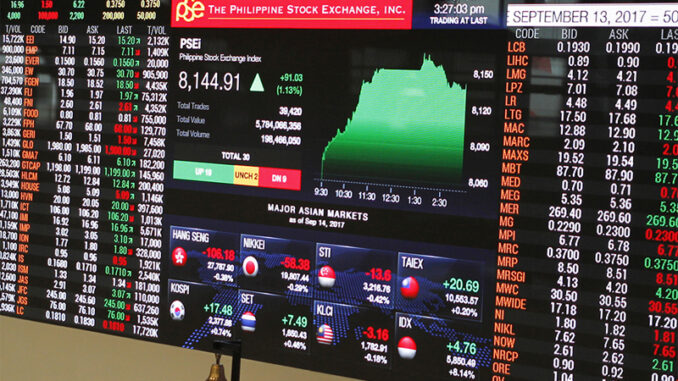
The Philippine stock market pulled back on Wednesday as investors took profits after four straight days of gains.
The 30-company Philippine Stock Exchange index lost 69.59 points, or 0.94 percent, to close at 7,362.62, while the broader all-shares index went down by 23.86 points, or 0.60 percent, to settle at 3,939.64.
“The market pulled back as investors took profits from its recent rallies,” said Philstocks Financial Inc. research head Japhet Tantiangco.
Analysts said the market’s decline represented a healthy correction as the index reached the overbought territory after hitting the 7,400 level.
Five of the six sectoral indices ended in the red. Financials dropped 2.02 percent, while services slipped 0.71 percent. Holding firms decreased 0.55 percent, while property and industrial edged lower by 0.42 percent and 0.17 percent, respectively. Mining and oil surged 2.83 percent.
Universal Robina Corp. was the top index gainer, climbing by 2.16 percent to P104.20, while Bank of the Philippine Islands was the day’s main index laggard, plunging by 4 percent to P132.
Despite the market’s decline, value turnover was strong at P7.54 billion. Foreign investors remained net buyers, with net inflows reaching P921.22 million.
Meanwhile, Hong Kong and Shanghai extended gains Wednesday as China announced another interest rate cut the day after unveiling a series of measures to boost the country’s ailing economy.
However, after a bumper start to the day — building on Tuesday’s rally and following a record performance on Wall Street—most other markets fell as traders took a breather.
The shift by China to provide support to an economy battered by a long-running debt crisis in the property sector and weak consumer spending added to the upbeat mood among traders after the Federal Reserve’s bumper rate cut last week.
On Wednesday, the People’s Bank of China said it would snip the medium-term lending facility — the interest for one-year loans to financial institutions — from 2.3 percent to 2.0 percent. The rate was last lowered in July.
That came on top of Tuesday’s decision to lower other rates, loosen rules on how much cash banks must keep in reserve, provide bigger incentives to buy homes and plans to consider a stock stabilization fund.
The moves suggest Beijing is giving way to calls to boost the world’s number two economy as it struggles to recover from the Covid-19 pandemic, even after the removal of painful restrictions at the end of 2022.
Chaoping Zhu, global market strategist at JP Morgan Asset Management, said: “We believe these steps are in the right direction. The sense of urgency may convince investors that more policy support is on its way.”
Hong Kong and Shanghai both rallied around one percent Wednesday, while Taipei also advanced but worries that a lot more work was needed to help the Chinese economy bounce back weighed on sentiment elsewhere.
Tokyo, Sydney, Seoul, Singapore, Wellington, Bangkok, Manila, Mumbai and Jakarta all fell along with London, Paris and Frankfurt.
Ray Attrill, head of forex strategy at National Australia Bank, said that while China’s measures “collectively look highly meaningful, (they) will need to be complemented by a major shift in fiscal policy thinking if they are to be regarded as very much more than the proverbial ‘pushing on a string’.
“This is in terms of their ability to drive a meaningful turnaround in domestic consumer confidence and spending, via instilling confidence that a floor under house prices and domestic equity prices — the main two ways in which Chinese households hold their wealth — is to hand.”
Traders are also awaiting the release Friday of the US personal consumption expenditures index — the Fed’s preferred inflation metric — hoping for an idea about its next interest-rate move.
The US central bank’s jumbo cut last Wednesday ramped up hopes that it will embark on a series of reductions as prices come under control and the jobs market slows, with many observers confident the economy is on course for a soft landing.
Officials are expected to continue easing policy through to 2026, according to the Fed’s “dot plot” guidance on rates released last week.
The prospect of more cuts helped gold hit a new peak of $1,670.57 as investors seek out better returns in the precious metal, which is also providing safe haven sanctuary from geopolitical tensions, particularly in the Middle East. With AFP


Be the first to comment